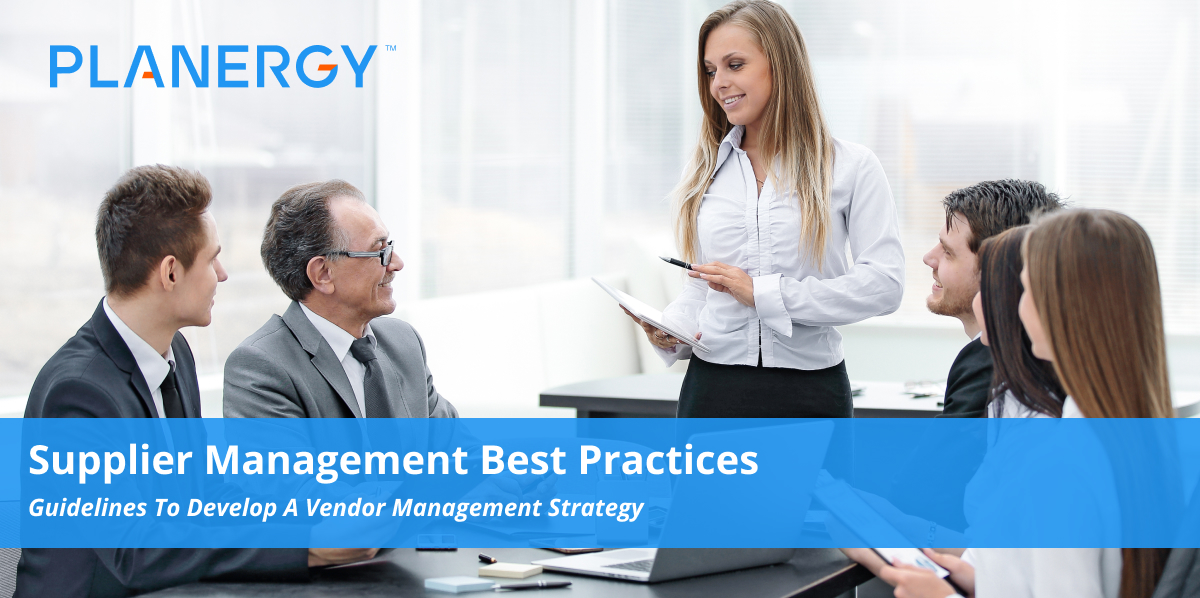Anyone responsible for a business’s procurement knows that supplier management is a major part of the job.
When done well, it can make you a company superstar. But when managed poorly, it can add an extra layer of stress.
Poor supplier management can cause a number of issues such as:
- Missed savings opportunities
Supplier performance issues as a result of unclear requirements and a lack of oversight - Incapable of adapting to change within the organization or scale quickly enough
- Unable to anticipate and react to price changes and market fluctuations/volatility
- Heavier workload because of ineffective and complex processes
Working to build a strong supplier management process enables a company to mitigate the risks and ensure their supply chain operates smoothly while meeting KPIs.
As you work to build the right supplier management system for your business, consider these best practices.
Determine Business Requirements
Procurement is about more than cutting costs and trying to find the least expensive deal. And the ideal World, procurement needs to be business-driven and work alongside your overall company strategy.
This involves smart asset utilization, making efforts to mitigate risk, and working to ensure undisrupted supply so that your company can continue to grow.
To execute this well, cross-team communication is essential.
The only way you can answer your procurement strategy is properly aligned with the rest of your business to accomplish goals is by getting input from all teams.
It’s only when their procurement team understands what the business needs that they will be able to avoid mistakes in choosing new vendors and negotiating deals.
By properly aligning your business goals, you can also help with measuring vendor performance and prioritizing them.
Develop a Vendor Management Policy
A vendor management policy is a document that tells senior management and the board members about all of your vendor management activities.
The more comprehensive your policy is, the better as it serves as the foundation of strategic and robust management practice.
The best way to ensure you have a solid vendor management policy is to form a purchasing committee.
This committee should be made of people such as the vendor manager and executive, unit managers, and any other key stakeholders.
The committee should regularly discuss policy, performance, and refocus in response to any changing conditions.
The policy must outline who’s responsible along with a general outline of how the department works, and the oversight standards.
Your vendor management policy should be written as a form of document.
Management needs to improve approve the policy which outlines how you will keep stakeholders informed.
Your company’s purchasing strategy must be aligned with your overall strategy in order to keep your company competitive.
The vendor management policy document should also outline the ideal number of vendors based on the categories you established.
Consider risk factors, how diverse your requirements are, and how Dynamic your Market is. After you make this calculation, your vendors will give you a competitive advantage.
The document should also outline a process for vendor review and selection. It should include the parameters that make sense for your company so that you can move forward when planning site visits and auditing requirements.
Your vendor policy should also help to establish your risk assessment principles including Financial, legal, and information security risk.
As you verify vendors, look for independent documentation such as bank statements and tax records. Depending on how big your company is, you may need to invest in a risk assessment professional or establish a risk assessment committee.
This policy will also include the metrics you want to monitor.
These KPIs should include data that you capture and measure objectively as well as contextual factors and qualitative observations.
Start Business Relationships Off with a Solid Contract
When you create vendor contracts, you need to make sure they clearly outlined responsibilities.
As you draft these contracts, make sure they follow your vendor management policy guidelines.
Define your scope of work (SOW) or service-level agreements (SLAs) outside of your boilerplate policy document. You need to include vendor-specific agreements that outlined the details to prevent issues in the future.
SOWs and SLAs document established the thresholds your vendors are required to meet.
They also include performance expectations, data breach management details, compliance requirements, and corresponding penalties for failure to operate within those confines.
Your contract should also include information-sharing expectations so that you can effectively work collaboratively with your vendors. You need to share information and priority as part of the agreement.
You should include your vendor strategies, objectives, plans, organizational details, and information about your tech stack.
You may also wish to include your organizational structure, your interest in and commitment to your customers, and your challenge areas. You may also include the vendor’s capabilities and investment areas.
Your contract should also include clearly delineated payment terms that describe the cost of services and products, the payment schedules, payees, and any late payment penalties.
Any U.S.-based vendors you do business with have to have to prove that they have a minimum of two types of insurance coverage.
They must show proof of worker’s compensation insurance, which provides wages and medical benefits to any employees injured while on the job.
They must also show third-party insurance or liability insurance to protect your organization from lawsuit liabilities and the insured vendor if someone sues it for claims under the policy coverage.
Your contract also needs to include information about fourth-party stipulations as vendors may subcontract work to others to supply products and services.
The move forward confidently, ensure that your third party identifies any fourth party subcontractors they may work with and monitors that party’s compliance with your contractual agreements.
Create and Maintain a Supplier Database
It’s crucial to own a detailed and current supplier database as this will help in planning, reducing costs, choosing new vendors, and promoting strong supplier relationships.
This database should include the following information on each supplier your company uses:
- Contact details
- Information on supplier capabilities
- Proposals and contracts
- Supplier locations in shipping coverage
- Invoices and transactional information
- Supplier performance data and feedback
- Other deemed crucial to your business
Segment Suppliers
Take some time to develop a set of criteria to segment your suppliers to prioritize them.
This will help you determine which suppliers are most crucial for your business success so you can focus efforts on those relationships.
There are a number of ways you can prioritize your suppliers for segmentation including:
- Size and type
- Quality of service
- Potential future value
- Speed of delivery
- Risk factors
Use the Kraljic Matrix to sort suppliers based on leverage items, strategic items, non-critical items, and bottleneck items. The suppliers who provide your raw materials are among the most crucial because without them, you cannot move forward with production.
After you’ve implemented your supplier segmentation, you’ll be able to choose the best supplier for every situation based on your business goals and objectives.
Use Continuing Education for Your Team
For the greatest success, you must identify areas of potential improvement and growth inside your procurement team.
Then you can devise a plan of improving individual competencies.
You can do this by setting up an in-house training program or paying for courses and creating a positive environment that encourages people to share what they know and help each other.
Clearly Define Team Member Responsibilities
Since supplier management involves multiple decision-makers and calls for cross-team cooperation, it’s easy for roles and responsibilities to get confused and blur together.
If there isn’t a clear reporting sequence, decision-making becomes difficult or impossible.
Because of this, it’s crucial to set up a concise, clear reporting chain along with a transparent workflow.
This way, each team member becomes aware of their responsibilities and how much they need to be involved.
Having a document on hand to reference can clear up any potential confusion can how to avoid internal conflicts and keep things running smoothly.
By mapping responsibilities and workflows, you can easily identify your team’s capacity and determine if you need to hire any additional staff.
Implement a Supplier Management System
Using technology and the power of Automation in your purchasing process can help improve efficiency while minimizing communication issues.
For instance, with an advanced purchasing tool like PLANERGY, your procurement team can quickly produce purchase requisitions and purchase orders that are automatically routed to the appropriate supplier.
You can also use PLANERGY to:
- Store your supplier information along with their product catalogs
- Order items directly from supplier catalogs
- Store contracts and purchase agreements in a central location
- Control budgets
- Create spending reports
- Control purchase approval processes and workflows
Effective supplier management is about more than strategic sourcing. It also involves risk management, supplier relationship management (SRM), and contract management.
Monitor and Assess Supplier Performance
To build successful and long-term supplier relationships, you must manage your vendor performance.
That means you need a structured and transparent evaluation system. it helps to keep your vendor relationships objective while also minimizing risks.
You can easily provide your suppliers with feedback and prompt them to act on things you need to improve their service.
This means taking the time to build supplier scorecards. A solid scorecard incorporates:
- Tangible metrics to measure performance
- A list of requirements for the supplier
- Alignment to your compliance and policies
- Alignment to your business goals
Regularly Perform Risk Assessments
You must always account for potential supply chain disruptions. As a lockdown and covid-19 pandemic has shown us, there is always room for uncertainty and volatility.
By identifying potential disrupting factors as early as possible and listing them according to their severity, your business can develop a plan of action to work around them.
Take time to identify your strategically crucial suppliers, goods, and services.
Develop a set of contingencies that can help you keep business running as usual if there are any supply chain interruptions.
Inform your team on how they need to act in those situations so they can make quick and informed decisions.
It’s smart to develop a supplier risk assessment program and evaluate the pliers with the listed mind.
As you develop your supplier risk assessment program, you should:
- Assess suppliers based on risk, spend, and geography. Globalization of your supplier base can be a good thing, but it may also introduce more risk.
- Validate all documents you collect on your suppliers
- Adjudicate data for false positives
- Consistently report on measurable compliance standards
- Continually monitor your supplier performance with ongoing third-party verification of supplier information
No matter the size of your business, supplier performance management is a crucial part of your success.
Even if you’re only dealing with a handful of suppliers now, as your business grows you may need to add more options into the mix.
Nailing down a process early on helps to increase profitability by finding cost savings and helping to streamline your business processes.
Even if you’ve been in business for years and have a lot of supplier data on hand, taking the time to evaluate your current supply chain management practices can help you find ways to improve efficiency which will pay off in the long run.




